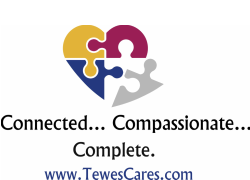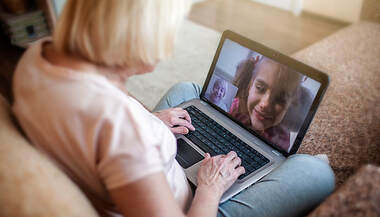|
If you are like 68% of grandparents, you live too far away for regular interactions with your grandchildren. No reading bedtime stories or soothing little tears. No ticklefests or hands-on projects. These casual yet meaningful activities just aren't an option. Video visiting helps. But according to Kerry Byrne of The Long-Distance Grandparent, you can count on only about a minute of video engagement for every year of your grandchild's age. Here are some tips for building an online relationship:
Interactive apps that might be of interest. The "Longevity Explorers," a grassroots group of tech-savvy seniors, recommends these apps for their high interactivity. The parents will need to download a version too in order for these to work.
Let us help you stay connected. Call 203-826-9206.
0 Comments
A vast majority of older adults (77%) say they want to remain in their own homes as they age. Of course! Home is comfortable: We know where everything is—in the house, and also in the neighborhood and town. Friends, doctors, grocery store. We know how to get around quickly and easily. Plus, the emotional benefits of memories, identity, and history are baked into the walls of a home. But for many, the concept of staying put is based on how things are now and doesn't factor in the changes that are bound to come: The need for help with shopping and meal preparation, housekeeping and repairs, yardwork, and transportation. And in the very last chapters of life, assistance with personal care such as bathing, dressing, and continence issues. There is also the possibility of dementia (33% for persons 85 and older), which may prompt a need for help earlier than imagined. And with that, the fact of care providers coming in and out of the house. If you plan on aging in place, it may be necessary to
Would you like help planning to age in place well? Give us a call at 203-826-9206. Especially for older adults living alone, the ability to summon help in the event of an emergency—such as a fall—is a very real concern. With a cell phone in your purse or pocket, it's easy to feel well set. Think again. The bathroom is where most falls occur. Do you take your cell phone in when you are using the toilet? Or taking a shower? And what if you hit your head and are unconscious? With a brain bleed, minutes count!
But who wants to wear one of those telltale pendants? Fortunately, with the advent of smartwatches, there are stylish options that do not carry such stigma. Look for a smartwatch with some or all of these features.
Give us a call at 203-826-9206. Three out of five (61%) of adults over 60 feel they have more stuff than they need. And yet many of us find it emotionally painful to cull our belongings.
While the physical labor of "right-sizing" is daunting, perhaps more powerful—and surprising—is the emotional challenge. For instance, you may feel that letting go of grandmother's wedding dress is like putting her in the trash. Or that if you discard your high school debate trophy, it's like that part of you has died. Or that giving away the fabric you bought to make a quilt "one day" is like abandoning your inner artist. It's human nature to imbue belongings with meaning, and it's those heartstrings that give us pause. Some tips to help you let go Recognize that some belongings need "safe passage." You want to find a place or person who will cherish and appreciate them. This will take time. But if you are persistent and start well before a deadline—six months or more before a move, for instance—you have a greater chance of placing them in good homes. Build momentum. If you cull strategically and make it a routine, it gets easier over time. Start with large items, maybe a mattress or golf clubs you no longer use. Large items are an easy first win. Next, turn to items currently gathering dust in the basement, attic, or storage. These are often a quick release. Turn to the clothes closet after that. The comfort of your existing clothes may help you let go of those garments you no longer wear. Files are the next. They take time to go through. Consider bulk shredding rather than doing it yourself. (The IRS says you do not need to keep records any longer than three years.) Photos, old letters, and journals are the last. If you don't recognize the people, it may be time to let them go. As for that letter from your high school sweetheart, maybe save it in a box labeled "throw away." Some things are too precious to let go of during your lifetime, but perhaps too private for others to find. Keep your eye on the prize. If you are downsizing to move, keep in mind the goals and life you imagine with your new digs. Who is the new you? It's easier to let go of the you-from-the-past if you focus on your future self. If you are decluttering on principle, remember that people who have completed the project say they feel so much lighter. It's an accomplishment that leaves them feeling freer to explore new vistas. Hire a professional to help early on. Especially if you are on a deadline. A person trained in late-life moving can help you honor your feelings and streamline the process. Looking for help? Give us a call 203-826-9206. Do you find yourself more easily distracted these days? There is good reason: Concentration is about keeping what's useful top of mind while at the same time suppressing thoughts that distract from your primary objective. As we age, the "executive" center of the brain becomes less able to sort out distractions. It's a filtering process that requires heavy brainpower. Many people worry that lapses in concentration are an early sign of Alzheimer's. Not necessarily. While memory and focus are related, they are not the same thing.
If you are concerned about increasing distractibility
Are you worried about concentration and focus? Let's talk about the possibilities. Give us a call: 203-826-9206. Learn more about our services. Are you tired of long waits to get an appointment? Rushed visits? Not being able to talk to your doctor by phone or communicate via email?
You aren't alone. Doctors dislike it too. But because most physicians today are employees of a large medical group, they are required to complete 30–40 patient visits per day. Appointments are set to last no more than 15 minutes. This is necessary to manage a typical patient load of 4,000. Some primary care doctors are moving away from this business-focused model of medicine. "Retainer-based," "concierge," or "boutique" medicine prioritizes the doctor–patient relationship. For an annual membership fee (average $1,500 – $2,400) you can join a primary care practice that is dedicated to staying small and intimate (≈150–600 patients). Your annual fee allows the doctor to guarantee
You pay the membership fee out of pocket. It is not covered by Medicare. You must also maintain an original Medicare policy and likely a supplemental policy since the concierge doctor will bill Medicare for office visits. As with traditional medicine, you also still have to pay your insurance premiums, deductibles, and copayments (unless your supplemental plan covers them). What to look for in a concierge physician
So far, there are only 12,000 concierge physicians nationwide, but the number is growing quickly! Interested in finding a concierge doctor? Give us a call at 203-826-9206. If you have trouble participating in conversation in a noisy room or tend to want the TV volume turned up, you might want to investigate a new category of device called an enhanced "hearable."
Up until now, there have been few options short of a hearing aid for people with only mild hearing loss. The best have been "personal sound amplification devices" that fit in the ear like a hearing aid. While reasonably affordable and easily purchased online, they have the disadvantage of amplifying all sounds, even the ones you don't want to hear. Modern hearing aids can distinguish between a conversation close by and the noisy chatter in a crowded room. The technology is expensive—in the four figures—and requires testing and fitting by an audiologist. Plus, many people feel a stigma attached to hearing aids. Enter the "hearable," a sophisticated amplification system that wirelessly connects to a mobile device. The hearables were invented for talking on your smartphone and streaming your favorite podcast. In the development of its very trendy "AirPods," Apple stumbled onto the realization that it was very easy to add an enhancement that adjusts for different listening situations. Other developers have since come out with wireless earbuds and improved hearing apps for both Android and iOS (Apple) devices. The result: No stigma. Less cost than a hearing aid. No need for an audiologist. Features to consider
The disadvantages. Hearables are not considered medical devices, so there is no FDA testing or oversight. They are not appropriate for moderate to severe hearing loss. They are designed for short-term use only, not for all-day wear (they need recharging after a few hours). They are visibly prominent. Someone seeing them in your ears during a conversation may assume that you are listening to music or are otherwise multitasking. Do hearing problems make it harder to enjoy your life? Let's talk about options. Give us a call: 203-826-9206. Learn more about our services. Are you enjoying a love you never thought you'd feel again? It's hard to be happy, though, if your children rain on your romance. Are they being selfish? Not necessarily. An in-depth study of "adult stepfamilies" revealed how disruptive it is when a parent gets involved with a new partner later in life.
The family tree changes! Even for adult children who are married with kids of their own, a deep—almost primal—sense of self is challenged when a parent brings in a new member. It brings up existential issues.
Reassurance. As you all strive to maintain the bonds of the original family while also making room for new connections, roles and expectations must come to a new balance.
We can help bring back the sunny days. 203-826-9206 Learn more about our services. There is no single test that can determine if a person has Alzheimer's disease. But a combination of several different tests can identify if memory and thinking problems are due to one of the many conditions that result in symptoms of dementia.
By process of elimination, doctors can determine what may be the root cause of thinking problems. Some conditions are treatable. Others are not. Advantages to getting tested early. If changes in memory and thinking are getting in the way of doing what you need or want to do in your life, ask your doctor for a checkup. Even if the source of your problem is not curable, getting a diagnosis as soon as possible has benefits. You can make lifestyle changes that might help slow disease progression and take advantage of medications that can lessen troublesome symptoms. You also become eligible to participate in clinical trials, which puts you in line for cutting-edge treatment. And knowing sooner rather than later gives you time to prioritize what you want to do in the near future, and to complete paperwork and make plans with your family about your wishes for later in the disease. The components of a full evaluation. To get a complete picture of your brain's health, figure on visits with several different specialists, each providing a unique perspective.
Let us guide you through the screening process. Call 203-826-9206. Learn more about our services. Study after study reveals that older adults with a sense of purpose, a sense of meaning in their lives, enjoy greater well-being and live longer than those without a life focus. They also have better cognitive and physical health and suffer less from depression, suggesting that purpose is an important component of a healthy and satisfying elderhood. To explore possibilities for yourself, try this simple two-step process. Begin by composing a purpose statement
Merge with activities. Unless your focus is on solitude and contemplation, consider the three types of activities below that research has identified as generally gratifying for older adults. Which of these best supports your purpose statement?
Give us a call at 203-826-9206. |
AuthorLeslie Alin Tewes is a Geriatric, Disability & Medical Care Manager; Elder and Adult Care Advocate; Quality Improvement Specialist. Archives
September 2023
Categories |











 RSS Feed
RSS Feed

